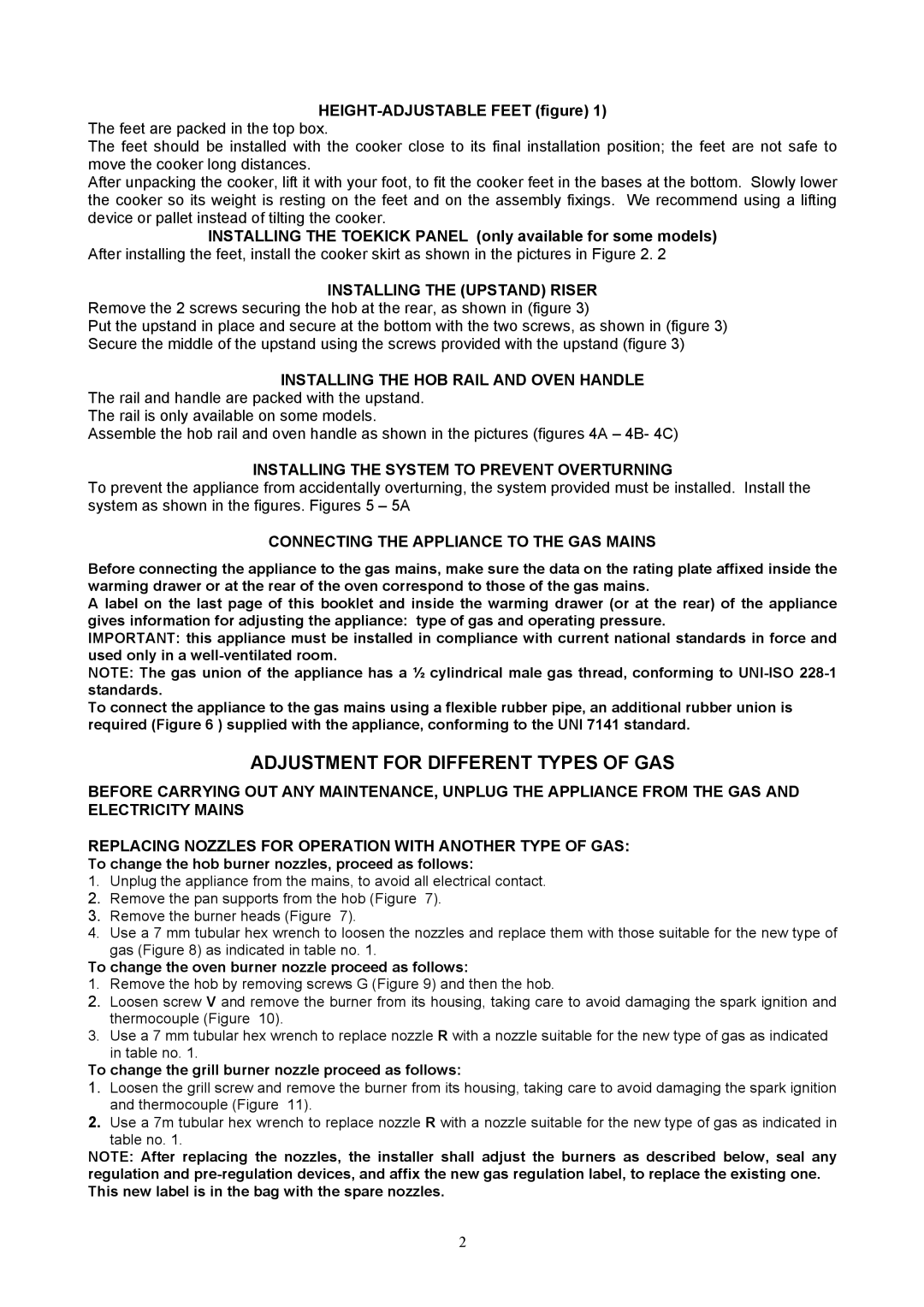HEIGHT-ADJUSTABLE FEET (figure) 1)
The feet are packed in the top box.
The feet should be installed with the cooker close to its final installation position; the feet are not safe to move the cooker long distances.
After unpacking the cooker, lift it with your foot, to fit the cooker feet in the bases at the bottom. Slowly lower the cooker so its weight is resting on the feet and on the assembly fixings. We recommend using a lifting device or pallet instead of tilting the cooker.
INSTALLING THE TOEKICK PANEL (only available for some models) After installing the feet, install the cooker skirt as shown in the pictures in Figure 2. 2
INSTALLING THE (UPSTAND) RISER Remove the 2 screws securing the hob at the rear, as shown in (figure 3)
Put the upstand in place and secure at the bottom with the two screws, as shown in (figure 3) Secure the middle of the upstand using the screws provided with the upstand (figure 3)
INSTALLING THE HOB RAIL AND OVEN HANDLE The rail and handle are packed with the upstand.
The rail is only available on some models.
Assemble the hob rail and oven handle as shown in the pictures (figures 4A – 4B- 4C)
INSTALLING THE SYSTEM TO PREVENT OVERTURNING
To prevent the appliance from accidentally overturning, the system provided must be installed. Install the system as shown in the figures. Figures 5 – 5A
CONNECTING THE APPLIANCE TO THE GAS MAINS
Before connecting the appliance to the gas mains, make sure the data on the rating plate affixed inside the warming drawer or at the rear of the oven correspond to those of the gas mains.
A label on the last page of this booklet and inside the warming drawer (or at the rear) of the appliance gives information for adjusting the appliance: type of gas and operating pressure.
IMPORTANT: this appliance must be installed in compliance with current national standards in force and used only in a
NOTE: The gas union of the appliance has a ½ cylindrical male gas thread, conforming to
To connect the appliance to the gas mains using a flexible rubber pipe, an additional rubber union is required (Figure 6 ) supplied with the appliance, conforming to the UNI 7141 standard.
ADJUSTMENT FOR DIFFERENT TYPES OF GAS
BEFORE CARRYING OUT ANY MAINTENANCE, UNPLUG THE APPLIANCE FROM THE GAS AND ELECTRICITY MAINS
REPLACING NOZZLES FOR OPERATION WITH ANOTHER TYPE OF GAS:
To change the hob burner nozzles, proceed as follows:
1.Unplug the appliance from the mains, to avoid all electrical contact.
2.Remove the pan supports from the hob (Figure 7).
3.Remove the burner heads (Figure 7).
4.Use a 7 mm tubular hex wrench to loosen the nozzles and replace them with those suitable for the new type of gas (Figure 8) as indicated in table no. 1.
To change the oven burner nozzle proceed as follows:
1.Remove the hob by removing screws G (Figure 9) and then the hob.
2.Loosen screw V and remove the burner from its housing, taking care to avoid damaging the spark ignition and thermocouple (Figure 10).
3.Use a 7 mm tubular hex wrench to replace nozzle R with a nozzle suitable for the new type of gas as indicated in table no. 1.
To change the grill burner nozzle proceed as follows:
1.Loosen the grill screw and remove the burner from its housing, taking care to avoid damaging the spark ignition and thermocouple (Figure 11).
2.Use a 7m tubular hex wrench to replace nozzle R with a nozzle suitable for the new type of gas as indicated in table no. 1.
NOTE: After replacing the nozzles, the installer shall adjust the burners as described below, seal any regulation and
2
